History of Nova Scotia
with special attention given to
Communications and Transportation
Chapter 22
1 January 1970 to 31 December 1979
Index with links to the other chapters
1970 February 4
Oil Tanker Arrow Wrecked
in Chedabucto Bay
On this day, the oil tanker Arrow ran aground in Chedabucto Bay, Nova Scotia, between Canso and Port Hawkesbury. Attempts by industry and government to prevent the loss of its cargo of Bunker C oil were unsuccessful. Clean-up efforts lasted for the next two years and cost about $4,500,000, but had little useful effect.
Thirty-two years later, in June 2002, Environment Canada conducted a three-day training exercise in Chedabucto Bay, and discovered considerable evidence of the wreck of the Arrow. "You can still smell the distinct smell of Bunker C oil," said Roger Percy, the head of the envorinmental emergency section for Atlantic Canada. "It's just like asphalt pavement in some areas. It's settled and is up to 12 inches 30 cm thick and hard as a rock."
The Liberian-registered tanker, under charter to Imperial Oil Ltd., had been carrying 108,000 barrels of crude oil to Nova Scotia when it sank in high winds and heavy seas.
[Halifax Chronicle-Herald, 8 June 2002]
[National Post, 8 June 2002]
How much oil was Arrow carrying?
How much oil is there in a barrel?
As a unit of measure, the barrel is notoriously difficult to pin down.
The official size of a barrel depends on what it contains. For
example, the beer barrel and the wine barrel are not the same size.
And historically, the size of the barrel has varied substantially
from one location to another, and from one century to another.
In the 1970s, the international oil industry – producers, shippers,
refiners, marketers, as well as governments – frequently used
the barrel as the unit of measurement. The standard legal definition
of the international oil barrel was:
one barrel = 42 U.S. gallons = 34.97 Imperial gallons
one U.S. gallon = 231.00 cubic inches = 3.7854 litres
Thus, one barrel of oil contains 159.0 litres.
(For most purposes, 160 litres is close enough to a barrel of oil.)
Arrow was carrying 108,000 barrels 17,300,000 litres of crude oil
when it ran aground on the shore of Nova Scotia in 1970.
|
1970 February 19
Harbourville Post Office Closed Permanently
Effective today, the Harbourville Post Office is closed. All mail formerly addressed to Harbourville and RR#1 Harbourville should henceforth be addressed to RR#5 Berwick. It is understood most Harbourville residents will have their roadside mail boxes near their homes, and a few will share a lock box. A resident remarked: "The closing of this post office is to be deplored — a sad sign of progress."
[30 Years Ago in the Berwick Register, 23 February 2000]
Harbourville, in Kings County, is located on the shore of the Bay of Fundy, about 13km north of Berwick.
1970 February 21
First Organized Snowmobile Race in the Annapolis Valley
The first organized snowmobile race to be held in the Annapolis Valley was successfully staged at the Meadowvale Raceway (probably Saturday, February 21st). It was the first competitive race to be held in the area and was sponsored by the Aylesford District Lions Club. It was estimated approximately 500 spectators were on hand to watch the thrilling events. The race was open to anyone who wished to enter and a number of drivers were present from around the Maritime Provinces, including Maritime racing champion Henry Wilson of Fredericton. He is the owner of several snow machines, among these a 776 c.c. (cubic centimetres) Blizzard, valued at $2,000.
[30 Years Ago in the Berwick Register, 23 February 2000]
1971 January 9
Last Day for Mail to Liverpool by Railway
On this day, the railway postal car that carried the Royal Mail between Halifax and Liverpool, Queens County, made its last trip. Railway passenger service along the South Shore, Halifax - Chester - Mahone Bay - Bridgewater - Liverpool - Shelburne - Lockeport - Yarmouth, had been terminated in October 1969. The Post Office had decided to switch postal delivery from the railway to highways. In addition, five of the CN's freight trains serving this route were being discontinued, reducing freight service from twelve trains a week in each direction, to seven.
[Thirty Years Ago column in the Halifax Sunday Herald, 14 January 2001]
The mail had been carried along the South Shore by the railway for 66 years, from the day it opened for regular traffic on 30 January 1905.
1971 January 20
Avon River Bridge Demolished
On this day, the Dominion Atlantic Railway bridge across the Avon River at Windsor was blown up, following completion of the causeway across the river. The railway's main line track had been relocated to cross on the new causeway, and the bridge was no longer needed. The easiest and cheapest way to bring it down was to use strategically-placed explosive charges to cut the steel at selected points, to allow the structure to fall onto the ice below, where it was speedily cut up and removed.
[Halifax Daily News, 20 January 2000]
1971 February
CJCH-TV Sold to CHUM Limited
In February of 1971, CHUM Limited purchased CJCH-TV Halifax. CJCB-TV Sydney was bought by CHUM in March 1971, and CKCW-TV Moncton, New Brunswick in April of 1972. When the purchases were complete, CHUM formed ATV (Atlantic Television Network) to serve the Maritimes.
1971 March 22
Electronic Media in Nova Scotia Legislature
Radio and television media were admitted to regular proceedings of the Nova Scotia Legislature, in a three-week experiment.
1971 September
First Personal Computer
256 bytes of memory
Kenbak-1
September 1971
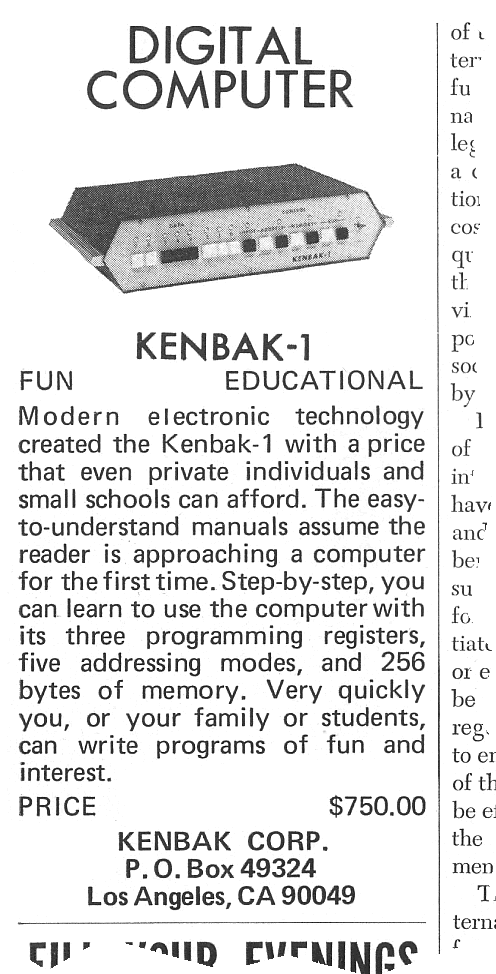
According to the Computer Museum History Center, the first device marketed as a personal computer was the Kenbak-1, which inventor John Blankenbaker advertised for sale for US$750 in Scientific American magazine in September 1971. If you havn't heard of the Kenbak, don't be surprised; Kenbak Corp. sold only 40 machines before closing shop two years later...
[National Post, 8 August 2001]
The above ad appeared on page 194 of the September 1971 issue of Scientific American. The same ad also appeared on page 81 of the November 1971 issue. (It did not appear in the October or December issues.) The name came from Blankenbaker.
1972
CBIT Goes On Air
CBIT Sydney began regular operation.
[CBIT Cape Breton Island Television]
1972
Hewlett-Packard Introduces the First
Hand-Held Scientific calculator
This nine-ounce battery-powered scientific calculator,
small enough to fit in a shirt pocket, had
logarithmic, trigonometric, and exponential functions
and gives answers to ten significant digits
If you were born after 1960
chances are you've never used a slide rule,
maybe you've never even seen one
The HP 35, introduced in 1972, was the world's first handheld scientific calculator. In one of the most amazing displacements in the history of technology, the HP 35 electronic calculator quickly replaced the faithful "slip-stick" — the slide rule — used by generations of engineers and scientists for rapid calculation and simple computation. Until the 1970s, every high school physics student was required to have his/her own 25cm slide rule. Every high school physics classroom had a large
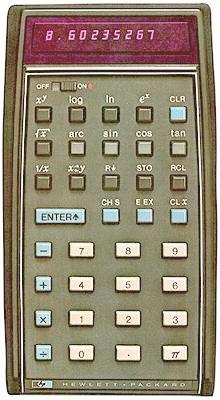 demonstration slide rule, which was used to teach students how to use their slide rules. By the 1990s, one generation after the invention of the HP 35, few high school physics students even knew what a slide rule is.
demonstration slide rule, which was used to teach students how to use their slide rules. By the 1990s, one generation after the invention of the HP 35, few high school physics students even knew what a slide rule is.
When Hewlett-Packard introduced the HP 35, a small revolution took place in shirt pockets around the world. It began in the early 1970s, when HP co-founder Bill Hewlett, impressed by the small size of an arithmetic calculator he'd seen, became convinced that HP could expand the technology into a pocket-size calculator capable of performing trigonometric, logarithmic and exponential functions. The result was the HP 35 — named for its 35 keys — a product that fundamentally changed the way engineers, scientists, mathematicians and students worked and banished the slide rule to the history books. A marketing study done in early 1971 alerted HP that there was a small market for a pocket-size calculator with scientific and mathematical functionality — it also recommended that the new calculator be the size of a typewriter or adding machine. But Bill Hewlett was convinced that engineers would prefer a calculator that would fit into a shirt pocket. Bill was right.
In the first three years after its introduction in 1972, sales of the HP 35 exceeded 300,000 units. The little "electronic slide rule" weighed only 250 grams. The device made it possible to make complicated calculations in the field and on the road with the speed and accuracy that far surpassed that of a slide rule and sold for $395 U.S.
Before the introduction of the HP 35, most people calculated more complex mathematical operations, such as reciprocals, trigonometric functions (sines, cosines, tangents, arcsines...) exponents (squares, cubes, square roots...) etc. with a slide rule.
 If you were born after 1960, chances are you've never used a slide rule — maybe you've never even seen one. The HP 35 automatically placed the decimal point in the result, which no slide rule ever did. The placement of the decimal point was one of the tougher skills for novice slide rule users to learn, but the need for this skill simply disappeared when the calculator arrived.
If you were born after 1960, chances are you've never used a slide rule — maybe you've never even seen one. The HP 35 automatically placed the decimal point in the result, which no slide rule ever did. The placement of the decimal point was one of the tougher skills for novice slide rule users to learn, but the need for this skill simply disappeared when the calculator arrived.
Earlier calculators handled only four functions: addition, subtraction, multiplication and division. The HP 35 not only performed complex scientific and mathematical functions, but it was also the first calculator to use Reverse Polish Notation for programming efficiency. The HP-35 manual: The HP-35 has far more computational power than previous pocket calculators. Its ten digit accuracy exceeds the precision to which most of the physical constants of the universe are known. It will handle numbers as small as 10-99 and up to 1099 and automatically places the decimal point for you. It is the first pocket calculator to provide you with transcendental functions like logarithms and sines and cosines. The operational stack and the Reverse Polish (Lukasiewicz) notation used in the HP-35 are the most efficient way known to computer science for evaluating mathematical expressions.
Manufacture of the HP-35 ceased in 1975.
Sources:
The 'Powerful Pocketful': an Electronic Calculator Challenges the Slide Rule
Hewlett-Packard Journal, June 1972
http://www.hp.com/hpj/72jun/ju72a1.htm
HP celebrates the 25th anniversary of the HP 35
Hewlett-Packard Journal, 26 September 1997
http://www.hp.com/abouthp/features/hp35calculator/
References:
Dave Hicks' Museum of HP Calculators website at
http://www.hpmuseum.org/
Explanation of Reverse Polish (Lukasiewicz) Notation
http://www.hpmuseum.org/rpn.htm
Jan Lukasiewicz, 1878 - 1956
http://www.fmag.unict.it/PolPhil/Lukas/Lukas.html
http://www-groups.dcs.st-and.ac.uk/~history/Mathematicians/Lukasiewicz.html
http://www-groups.dcs.st-and.ac.uk/~history/References/Lukasiewicz.html
http://www.math.bme.hu/mathhist/Mathematicians/Lukasiewicz.html
http://www.hd.uib.no/corpora/1995-2/0155.html
Slide Rules
Keuffel & Esser Company 1867-1987, manufacturer of Slide Rules
http://www.sphere.bc.ca/test/ke-sliderule.html
Slide Rules, history and explanation of
http://www.hpmuseum.org/sliderul.htm
Eric Marcotte's Keuffel & Esser Slide Rules (many pictures)
http://tor-pw1.netcom.ca/~marcotte/ke.htm
Advertisement, Penn State Engineer, October, 1953
Keuffel & Esser Slide Rules
http://weblab.research.att.com/~davek/slide/kne/
Log-Log Duplex Decitrig, K&E 68 1210, perhaps the best slide rule ever made
http://weblab.research.att.com/~davek/slide/kne/lldd.html
John Current's Slide Rule Website
K&E, Dietzgen, Pickett, Faber-Castell, Jason...
http://home.att.net/~jcurrent/srule.htm
Dietzgen Model 1732 Maniphase Multiplex Decimal Trig Type Log Log Slide Rule
http://home.att.net/~jcurrent/diet1732.htm
Todd Tolhurst's Slide Rule Collection
http://www.w3xpert.com/toto/sliderules/
Sphere Research Slide Rule Site
http://www.sphere.bc.ca/test/sruniverse.html
Kung's Slide Rule Links
http://www.post1.com/home/kung/srule.htm
1972 January 1
End of Cigarette Advertising
on Radio and TV
Canadian cigarette manufacturers and distributors were ordered to end radio and television advertising, effective this day.
[Halifax Daily News, 21 September 1999]
1972 September
ATV Begins Regular Operation
The Atlantic Television Network, comprised of three television stations, CJCH-TV Halifax, CJCB-TV Sydney, and CKCW-TV Moncton, began operation.
1972 November 9
Anik A1 Satellite Launched
On this day Telesat Canada made history with the launch of the world's first commercial
communications satellite - the Anik A1. Anik is an Inuit word for brother and should be pronounced a-NEEK. Before Telesat's Anik A1, communications satellites such as Telstar could only transmit for a few hours a day, because they moved faster than the earth's rotation. By succeeding in launching a satellite into a geostationary orbit above the equator, Telesat was able to bring Canada the world's first national satellite broadcasting system.
1973 July 1
Cape Breton Steam Railway Opening
On this day, the Cape Breton Steam Railway's inaugural train pulled into the Victoria Junction station. Steam locomotive number 42 pulled three ex-Canadian National passenger cars, Miners' Museum, Ocean Deeps Colliery, and Fortress of Louisbourg. The CBSR owned no track; its trains ran on the Lingan Branch of the DEVCO Railway.
1974 September 3
Metric System Comes to Yarmouth
In an effort to help adults to become more familiar with the metric system of measurements, now replacing the familiar Imperial system of measures, the local continuing education program in Yarmouth was planning a course on the subject. "Already the change to metric terms is being introduced for study in the public school system."
[Yarmouth Vanguard, 3 September 1974]
1974 November 16
The Whiskey Wreck at Ingramport
In the evening of this day, CNR freight train number 518, from Bridgewater to Rockingham, was wrecked at Ingramport. At the west end of the siding, mile 25.7 of the Chester Subdivision, an open switch derailed two diesel locomotives and seven cars. The cause was traced to children who had broken the switch lock and left the handle raised above the proper locked position. The vibration of the train caused the switch points to move far enough to catch the wheel flanges. The diesel units were numbers 1330 and 1327. The derailed cars included two box cars loaded with cases of distilled spirits in bottles. These had been loaded at the Bridgetown bottling plant, which was served by a spur from the CN main line; the Bridgetown bottler was the last customer (nearest to the end of the line) after the track to Port Wade had been abandoned. These two cars had travelled from Bridgetown over the CN track through Middleton, Springfield, New Germany, Bridgewater, Mahone Bay, and Chester, to the wreck site. The news spread quickly, that two carloads of whiskey had been wrecked at Ingramport. The wreck site was only a one-minute walk from Highway 3, and a crowd of onlookers gathered to view the proceedings, and to "case" the two boxcars full of liquor, with their mostly intact cargo. CN police kept these cars under continuous surveillance, but it is said that, through the night following the wreck, some of the unbroken bottles found their way to unauthorized destinations. The next day, CN retrieved some of the liquor, but most of it was dumped at the wreck site and buried by a bulldozer. The dumped cases were pushed into a hole dug for the purpose, and covered with earth — after the dozer driver, as instructed, ran the heavy machine back and forth over the dumped cases, to ensure that the bottles were crushed and the contents could not be salvaged by anyone. The CN track through Ingramport was abandoned in 1994, but, in 1997, the location of the wreck is easily found, and it could be that some future archaeologist will dig through those piles of crushed glass. Some say that a few bottles remained unbroken, despite the bulldozer's best efforts. [The last revenue traffic on that siding, about 1989, was a boxcar loaded with flour for Snair's Bakery at Black Point.]
1975 January
Kentville Town Hall Gets a Computer
An NCR 399 computer was installed in the Town Hall at Kentville, Kings County, Nova Scotia.
[25 Years Ago in the Kentville Advertiser, 4 January 2000]
The National Cash Register Company was founded in 1884.
In 1974, the company's name was changed to NCR Corporation.
Source: http://www.ncr.com/history/history.htm
Pictures of an NCR 399

NCR 399: nameplate
Source: http://www.montagar.com/~patj/ncr399f.jpg
Source: (six pictures)
Dallas/Fort Worth Historical CPU Preservation Society
http://www.montagar.com/~patj/ncr_01.htm
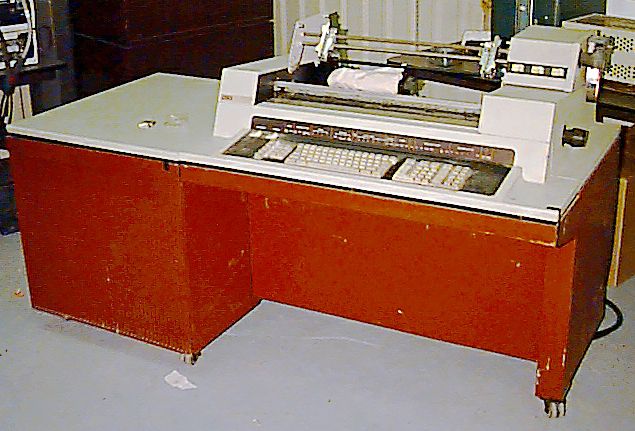
NCR 399: The system console, which includes the CPU and the very wide printer and keyboard
along with a tape loop, weighs about 500 lbs. about 230kg. It has
core memory.
Source: http://www.montagar.com/~patj/ncr399a.jpg
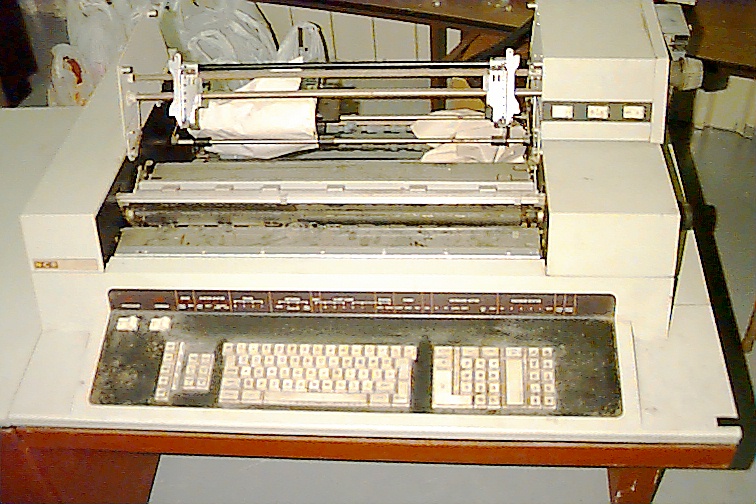
NCR 399: keyboard
Source: http://www.montagar.com/~patj/ncr399b.jpg

NCR 399: side view showing tape loop
Source: http://www.montagar.com/~patj/ncr399c.jpg
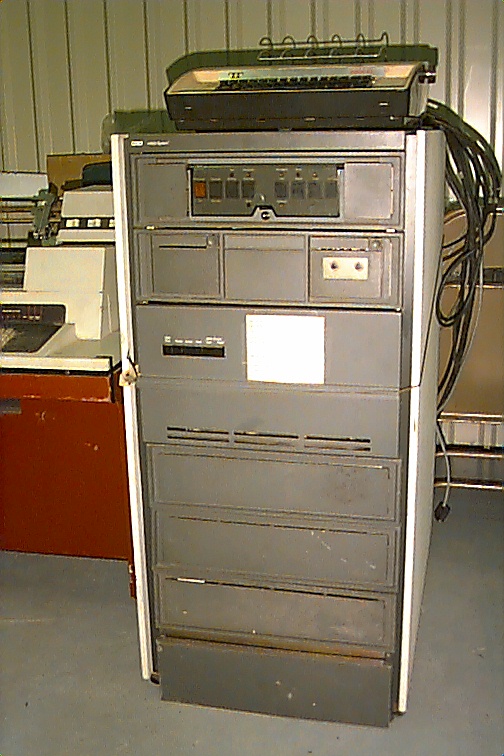
NCR 399: Data storage is in a separate cabinet. There are two fixed disks
and an RL0x-like removable media drive. Teleprinter on top.
Source: http://www.montagar.com/~patj/ncr399d.jpg
The NCR399 also stored data on a "magnetic ledger" (a sheet of paper with a
magnetic strip which could be inserted into the printer and read, and printed on.)
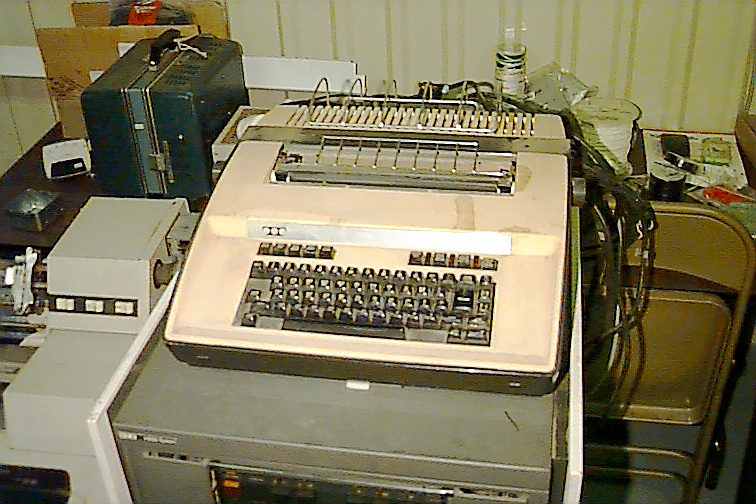
NCR 399: A couple of these Teletype brand teleprinters came with the NCR.
Source: http://www.montagar.com/~patj/ncr399e.jpg
These six pictures (above) originated at the
Dallas/Fort Worth Historical CPU Preservation Society
Date: Sat, 03 Aug 2002 23:01:23 -0700
From: Patrick Jankowiak, curator of the Dallas/Fort Worth Historical CPU Preservation Society:
...We happen to have an NCR399. It isn't in very good shape, but it is whole. I think it may be the only one left ... Nobody remembers what an NCR399 is anymore...
A Programmer's Perspective:
Subject: Be Afraid, Be Very Afraid (NCR 399)
I just happened to find your NCR399 page by mistake. Oh my God! I can't believe those are still around anywhere! I would have thought that anyone who had ever programmed one would have made it a personal goal to destroy any remaining ones. :-)
My first job out of school was for NCR. I spent the better part of three years programming that monster and installing them around Massachussetts. When I first started using it, we only had two cassette tape drives on it. To compile, you had to have one tape for your source, another for the compiler, and another for the linker, and finally one to write your object code to, It would take about 30 minutes to compile a program, and every 5 minutes or so you had to change tapes.
The programming language is Neat/AM (AM: accounting machine) The magnetic ledgers were a piece of ledger paper about 12 inches wide by 16 inches long. They had a piece of magnetic tape glued to the back which would store the information printed on the front. They were great transition systems for the small business which had always used paper ledgers to keep their books. The 399 let them keep their ledgers, but then they could feed the ledgers one at a time into the system where it would be read onto tape at the end of the month.
You would then have a statement program, or general ledger, or accounts payable which would read the tape and produce checks, or customer statements, etc.
You could also enter patches into the console after you had loaded a program. (I was known as "patches" by one of my customers for a time.) Oh well, enjoy it. It was kind of like seeing an old friend, after a long time, well sort of...
Words to live by with a 399... "If all else fails hit Halt, then reset, then compute."
Laura
Source: Dallas/Fort Worth Historical CPU Preservation Society
http://www.montagar.com/~patj/ncr_01.htm
|
1975 February
Kentville Telephone Exchange Converted
to Solid-State Switching Equipment
A whole new generation of solid state, computer controlled switching equipment, worth $5,000,000, is beginning to provide direct distance dialling for the 38,000 customers on the Kentville telephone exchange, owned and operated by MT&T, Maritime Telegraph and Telephone Company. The project, expected to be complete by March 1976, is replacing the Strowger electromechanical switching equipment — magnets, relays, stepping relays, etc. — which has been the core of this exchange for decades.
[25 Years Ago in the Kentville Advertiser, 22 February 2000.]
References describing the Strowger automatic (no operator required to make plug connections) switching equipment for telephone exchanges:
- The Early Years of the Strowger System, by R.B. Hill
http://www.privateline.com/Switching/EarlyYears.html
- The Strowger Telecomms Page
http://www.seg.co.uk/telecomm/index.htm
Until the 1990s, much of the telecomms infrastructre of the UK still relied on electromechanical switching, based on principles invented by Almon B. Strowger. Old Strowger exchanges were something to see, touch and hear...
- The Invention of Automatic Switching
http://www.seg.co.uk/telecomm/automat1.htm
In the 1880s, Almon B. Strowger developed a system of automatic switching using an electromechanical switch based around around electromagnets and pawls. With the help of his nephew, Walter S. Strowger, he produced a working model in 1888. Strowger switches remained a mainstay of dial telephone systems well into the 1980s...
- Automatic Exchange Implementation
http://www.seg.co.uk/telecomm/automat3.htm
- Strowger Demonstration Unit
http://www.seg.co.uk/telecomm/automat4.htm
1975 March
Cable TV Coming to Windsor
Cable television is now set to arrive in Windsor, after being held up by financial reasons and CRTC regulations. Those have now been resolved, and the method of sharing the cost of the microwave link has been settled. Local residents soon will be able to watch the additional channels brought by cable which are not available over the air. The cost is expected to be about $250,000 for the first phase. Phase 2 will extend the service to Hantsport, and phase 3 to outlying areas. Studio facilities in Windsor have already been set up.
[25 Years Ago in The Hants Journal, Windsor, 1 March 2000]
1975 April
First Mobile Telephone Customer in the Valley
Waterville businessman Cornelius Holleman became the first mobile telephone customer in the Annapolis Valley recently.
[25 Years Ago in the Kentville Advertiser, 25 April 2000.]
1975 April 1
Change to Celsius
On this day, Canadian radio and television stations began giving temperatures on the Celsius scale. Until today, the Fahrenheit scale had been used since the beginning of radio broadcasting.
[National Post, 1 April 2000]
1975 November
CBC's FM Stereo Network Starts Up
The Canadian Broadcasting Corporation's English FM (frequency-modulated) stereo network service was started in November, 1975, linking by microwave new and existing stations in St. John's, Halifax, Montreal, Ottawa, Toronto, Winnipeg, Calgary and Vancouver.
1975 December
Heavy Passenger Traffic on CN
The heavy holiday traffic in late December 1975 resulted in longer passenger trains and extra sections. Eastbound trains arrived in Halifax with up to twenty cars and five diesel locomotives, and on December 23rd #14 ran in two sections. Westbound, #15 ran in two sections a total of eight days. First 15 usually had 18 or 19 cars and Second 15 averaged 14 cars. The Sydney sections of #11 and #14 combined and split at Truro as usual, but the Gaspe sections ran through to and from Montreal.
[From the January 1976 issue of SRS News, a newsletter published by the Scotian Railroad Society.]
A regularly-scheduled passenger train usually has a fairly standard "consist," that is, under normal circumstances it is made up of pretty much the same number of cars for each trip. But sometimes there are unusual circumstances which cause a much larger number of people to want to travel — the Christmas and New Year's holidays have traditionally been times when the number of railway passengers is much above the average.
When extra passengers show up, railway managements can provide additional capacity by adding extra cars to the regular train. These extra cars make the train longer and heavier. The extra weight requires additional motive power — more cars means more locomotives must be placed on the train. These extra cars and extra locomotives make the train longer, and there is a limit to how long a train can be and still be worked properly along the line — for example, if the train becomes longer than the passing sidings there will be problems, and it is undesirable for a passenger train to exceed the length of the station platforms.
In practice, there is a limit to how many extra cars can be added to a passenger train. If there are more passengers than the longest feasible train can accommodate, the management often decides to run a second train, called a "second section." The First Section departs and travels according to the published schedule. The Second Section follows the First Section as closely as possible, perhaps twenty or thirty minutes later. The interval between the First and Second sections must be enough to ensure safe operation of the signalling and dispatching system.
When a passenger train runs in sections, it is obvious that the number of passengers travelling is much larger than usual. Sometimes the demand is so large that a train will be run in three or more sections. In 1946, the army ordered a special train to carry a large group of prisoners of war from detention camps in Upper Canada to Halifax to board ships to return them to Germany, and the newspapers of the day reported that this train ran in three sections. During World War Two, the passenger traffic on the Canadian Pacific Railway line between Saint John and Montreal was so heavy that trains 39 and 40 at times were run in eight sections.
1975 December
Waterville Airport
The Municipality of Kings County has been awarded a $50,000 grant from the provincial government to enable the purchase of the privately-owned airport at Waterville, Kings County. The transfer to municipal ownership will allow the airport to qualify for federal upgrading money.
[25 Years Ago in the Kentville Advertiser, 26 December 2000]
1975 December 26
DAR Passenger Train Wrecked at Avonport
The Dominion Atlantic Railway had to resort to chartered bus service between Kentville and Yarmouth for three days after Dayliner 9067 was damaged in a level crossing accident at Avonport, Kings County, on Saturday, December 26th. A dairy truck was unable to stop for the crossing due to icy roads. The truck driver was taken to hospital but no injuries to train passengers were reported. Dayliner 9067 was sent to Montreal for repairs and 9049 was brought in to replace it. The DAR operates two RDC-1s between Kentville - Yarmouth and Kentville - Halifax. (RDC means Rail Diesel Car.) Both are lettered CP Rail. When the DAR first placed dayliners in service 9058 and 9059 were painted with distinctive "Dominion Atlantic" lettering. Both have since disappeared to Upper Canada and have been relettered CP Rail.
[SRS News, volume 2 number 6, January 1976. This was a newsletter issued monthly by the Scotian Railroad Society, Halifax.]
1976 January
Continuous Welded Rail Installed
on Dartmouth Subdivision
Starting on January 12th, CN installed continuous welded rail in the railway's track between Windsor Junction and Dartmouth, known as the Dartmouth Subdivision. From mile 0.0 (Windsor Junction) to mile 8.0, rails in individual lengths of 1800 feet 549m were installed. From mile 8.0 to mile 10.0 (Wrights Cove), 78-foot 23.8m rails were installed — the shorter lengths being necessary here because of the large number of switches in Burnside Industrial Park. A rail cannot be continuous through a switch, it must be cut at the frog.
[SRS News, January 1976]
"Double-length" 78-foot continuous rails were widely used; they were made by welding together two of the 39-foot rails which were/are the standard length produced by rail manufacturers throughout North America. (When the H&SW track between Chester and Liverpool was dismantled in 1992, the scrapping contractor encountered many 78-foot rails.) Railways installed these double-length rails because they eliminated half of the rail joints, compared to the use of the standard 39-foot rails. The joints between rails were/are the source of much of the cost of maintaining track, and eliminating half of the joints would reduce maintenance costs significantly.
1976 January
Trenton Works Building Rail Cars for Cuba
The Trenton Works of Hawker Siddeley Canada Limited is working on a $3,500,000 order from Empresa Cubana Impreortadore de Ferrocarriles. The order, funded by the Export Development Corporation, is for fifty side-dumping iron ore cars, spare parts, related equipment, and technical assistance.
[SRS News, January 1976]
1976 January - February
The National Dream Rerun
The National Dream, CBC Television's series based on Pierre Berton's two best-selling books on the building of the Canadian Pacific Railway, will be repeated on national television, in the original eight episodes to be aired on successive Sundays at 7:00pm.
Jan 4 The Great Lone Land
Jan 11 The Pacific Scandal
Jan 18 The Horrid B.C. Affair
Jan 25 The Great Debate
Feb 1 The Railway General
Feb 8 The Sea of Mountains
Feb 15 The Desperate Days
Feb 22 The Last Spike
[SRS News, volume 2 number 6, January 1976]
1976 April 26
CN Passenger Schedule Changes
CN's new system timetable, which became effective on this day, made only minor changes in the passenger train schedules in the Maritimes.
Westbound: The Ocean, Train 15, leaves Halifax at 1130 instead of 1115 and takes 25 minutes longer for the trip to Montreal. The Scotian, Train 11, departs at 1715 as before but takes 20 minutes longer.
Eastbound: The Ocean, Train 14, leaves Montreal 10 minutes earlier and arrives at Halifax at 1555 instead of 1600. The Scotian, Train 12, is unchanged with a Halifax arrival at 2235.
There were minor time changes to other Maritime trains, but no new trains were added and no existing trains were curtailed.
[SRS News, volume 3 number 2, May 1976. This was a newsletter issued monthly by the Scotian Railroad Society, Halifax.]
1976 April 30
Railway Stations Closed
As of this day, CN train order offices at French Village, Chester Basin, Port Clyde, Tusket, New Germany, Bridgetown, and Caledonia were closed permanently. These stations were located along the Halifax & South Western Railway, which later became part of the Canadian National Railways system.
[SRS News, volume 3 number 2, May 1976]
1976 May
Telephone to Replace Morse Code
on the South Western
The train dispatching wire (the vital communications system that carries messages between the train dispatcher and the train-order offices in the stations) along the Halifax & South Western Railway will be changed over from Morse telegraph to telephone.
[SRS News, volume 3 number 2, May 1976]
1976 December
Highway 101 Opens, Berwick - Aylesford
A new section of Highway 101, 5.3 miles 8.5 km long, between Berwick and Aylesford in the Annapolis Valley, opened during the last week of December 1976. The next section to the west is set to be finished in 1977.
[25 Years Ago in the Kentville Advertiser, 1 January 2002]
1977 January 3
Apple Computer Incorporated
On this day, the Apple Computer company was incorporated in California.
1977 February 28
On this day, Parliament creates VIA Rail Canada Incorporated, to take over the operation of almost all passenger trains in Canada.
[National Post, 28 February 2000]
1977 March 17
R.B. Cameron Buys Kentville Publishing Company
On this day, R.B. Cameron "formally took control" of Kentville Publishing Company Limited ... A few weeks later, R.B. acquired Fundy Group of Yarmouth, which brought to eight the number of weekly newspapers in the fold ... Later The Berwick Register was acquired and I was offered the managing editorship of the group, which had now become incorporated as Cameron Publications Limited. I was pleased to accept...
[Harold Woodman's column "Fond Memories of R.B. Cameron," in the Kentville Advertiser, 29 February 2000. Robert Burns Cameron died in New Glasgow on 17 February 2000.]
1979 April 1
Letter Postage Increases to 17 Cents
Along with other Canadian postal rate increases which became effective on this day, the cost of mailing a first-class letter increased from 14 cents to 17 cents.
[Toronto Globe and Mail, 21 November 1978]
1979 September 4
Discovery Train Departs Yarmouth
The Discovery Train, a travelling exhibit sponsored by the National Museum of Canada, left Yarmouth after spending a couple of days there. The Vanguard reported that 12,840 people visited the train while it was in town. The Discovery Train arrived in Yarmouth over the track of the Dominion Atlantic Railway. From Yarmouth, the train went to Liverpool over the track of the Halifax & South Western Railway. The train was scheduled to make 43 stops all told during its 1979 tour.
[Yarmouth Vanguard, 4 September 1979]
There is an NFB film, 1978, 26 minutes in length:
Once upon a Train: The Discovery Train, Year One
The film chronicles the first year tour, 1978, across
Canada by the Discovery Train. It includes interviews
with visitors, and an overview of the train's exhibits.
|
1979 October 28
VIA Rail Takes Over The Atlantic
On this day, VIA began operating a new passenger train service between Halifax and Saint John, New Brunswick, shown in the railway timetable as trains 615, northbound from Halifax, and 616, southbound to Halifax. This was the same day that VIA Rail took over operation of the The Atlantic, a daily passenger train formerly operated by Canadian Pacific, running between Montreal and Saint John. Trains 615 and 616 were operated with RDCs (Rail Diesel Cars, often known as Budd cars).
[Volume 37 Number 3, dated March 1998, of Branchline, the monthly newsletter of The Bytown Railway Society, Ottawa]
1979 November 1
Lingan Generating Station Begins Regular Operation
The coal-fired Lingan Generating Station on Lingan Bay, near New Waterford, began operation on this day. In 1997, the Lingan Generating Station produced 4,455,000 megawatt-hours of electrical energy, a plant record.
[The Cape Breton Post, 19 October 1999]
Taking the value of one megawatt-hour of electric energy
to be worth about $50 (a reasonable estimate at this time)
the 1997 production of Lingan Generating Station works out
to be about $220,000,000, a daily average of about $600,000.
|
Wayback Machine
Wayback Machine
http://web.archive.org/index.html
"Use the Wayback Machine to view web sites from the past."
Archive of This Document:
History of Nova Scotia, Chapter 22
The Wayback Machine has copies of this webpage from the early days:
Archived: 2000 August 15
http://web.archive.org/web/20000815195401/http://www.alts.net/ns1625/nshist22.html
Archived: 2000 December 6
http://web.archive.org/web/20001206164100/http://epe.lac-bac.gc.ca/100/205/300/nova_scotias_electronic_attic/07-04-09/www.littletechshoppe.com/ns1625nshist22.html
Archived: 2001 February 8
http://web.archive.org/web/20010208225055/http://www.alts.net/ns1625/nshist22.html
Archived: 2001 April 19
http://web.archive.org/web/20010419135116/http://www.alts.net/ns1625/nshist22.html
Archived: 2001 August 16
http://web.archive.org/web/20010816212546/http://epe.lac-bac.gc.ca/100/205/300/nova_scotias_electronic_attic/07-04-09/www.littletechshoppe.com/ns1625nshist22.html
Archived: 2001 November 16
http://web.archive.org/web/20011116074501/http://www.alts.net/ns1625/nshist22.html
|
Index with links to the other chapters
Go To: History of Railway Companies in Nova Scotia
http://epe.lac-bac.gc.ca/100/205/300/nova_scotias_electronic_attic/07-04-09/www.littletechshoppe.com/ns1625railways.html
Go To: History of Automobiles in Nova Scotia
http://epe.lac-bac.gc.ca/100/205/300/nova_scotias_electronic_attic/07-04-09/www.littletechshoppe.com/ns1625automobiles.html
Go To: History of Telegraph and Telephone Companies in Nova Scotia
http://epe.lac-bac.gc.ca/100/205/300/nova_scotias_electronic_attic/07-04-09/www.littletechshoppe.com/ns1625telephone.html
Go To: History of Electric Power Companies in Nova Scotia
http://epe.lac-bac.gc.ca/100/205/300/nova_scotias_electronic_attic/07-04-09/www.littletechshoppe.com/ns1625electric.html
Go To: Index to other online Nova Scotia History
http://epe.lac-bac.gc.ca/100/205/300/nova_scotias_electronic_attic/07-04-09/www.littletechshoppe.com/ns1625histindx.html
Go To: Home Page
http://epe.lac-bac.gc.ca/100/205/300/nova_scotias_electronic_attic/07-04-09/www.littletechshoppe.com/ns1625index.html

W3C HTML Validation Service
http://validator.w3.org/

W3C CSS Validation Service
http://jigsaw.w3.org/css-validator/
Latest content revision: 2002 October 15


 demonstration slide rule, which was used to teach students how to use their slide rules. By the 1990s, one generation after the invention of the HP 35, few high school physics students even knew what a slide rule is.
demonstration slide rule, which was used to teach students how to use their slide rules. By the 1990s, one generation after the invention of the HP 35, few high school physics students even knew what a slide rule is.







![]()
![]()